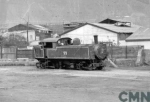Railway Campus Taltal. Taltal - CHILE
The town of Taltal stems from the discovery of the canton of Taltal nitrate, to carry out the pioneer José Antonio Moreno in the 1850s. The town grew based on mining and port facilities that build them Moreno 1858, to exploit and export the mineral. Under the 1866 border treaty between Chile and Bolivia, Taltal became the northernmost town in Chile. Under Taltal strategic importance and to encourage the nitrate industry, the Chilean government in 1877 ordered the layout and population of the city, which grew and developed in the middle of nowhere, thanks to the immense wealth of Nearby cantons, Taltal and Aguas Blancas. Taltal was, like Iquique and Pisagua large nitrate port.
The saltpetre was built by The Taltal Railway Co., an English company based in London. The work was carried out from 1882 with speed, efficiency and quality. In 1889 the line reached the terminus: Cachinal, 149km from Taltal .. The railway had branches in all regional offices. Together with the railway, port infrastructure, the company built in an area of about 15 hectares. The facilities including five docks, warehouses, bunkers, petty, platforms, engine house, and a rolling stock which came to consist of 560 cars and 22 locomotives.
Still standing on Pier No. 2, which is the last of the seven loading docks that had Taltal. Its length is 120 meters and a width of 12, and rests on 33 strains of 4 piles each. It beamed a metallic structure with transverse and longitudinal wooden piles are steel. The structure was manufactured in England and assembled in situ. Could support two locomotives with their carts loaded with salt, and ship the product from its two bands, through mailboxes still be distinguished. On the deck of the jetty are the ruins of two steam cranes operating in the loading and unloading. Taltal Municipality has managed with the National Regional Development Fund, a project to restore the pier, which will allow its conservation and pedestrian use.
Adjacent to the transportation infrastructure was the residential and offices, which follows a characteristic type of isolated houses, wood in a classic English style overseas, combining the bungalow of India with elements of Georgian. Most are Douglas Fir.
The railroad painfully endured the crisis and decay of nitrate and was sold in 1956 to Charles Rumi, a businessman dedicated to the dismantling of nitrate item. By then, they worked only three area offices: Germany, Flor de Chile and Chile. They were expropriated and given to SOQUIMICH in 1971. In 1974, the railway was restored to Rumi, who proceeded to disarm the facility. She stopped by 1982 when the bankruptcy of the company reduced Rumi became active in the hands of the Bankruptcy Trustee.
Supreme Decree 1294 declared historical monuments throughout the area of land he owned Succession Rumi and buildings then standing, namely, the Polyclinic, the House Administration Headquarters (or Management), the House of Locomotive Superintendent The House Chief of Warehouses and the employees home traffic, plus Pier No. 2. Supreme Decree No. 1221 of 10 May 1979, had also declared in the landmark category Locomotive No 59 to oil, which was imported in 1906 by the saltpetre.


